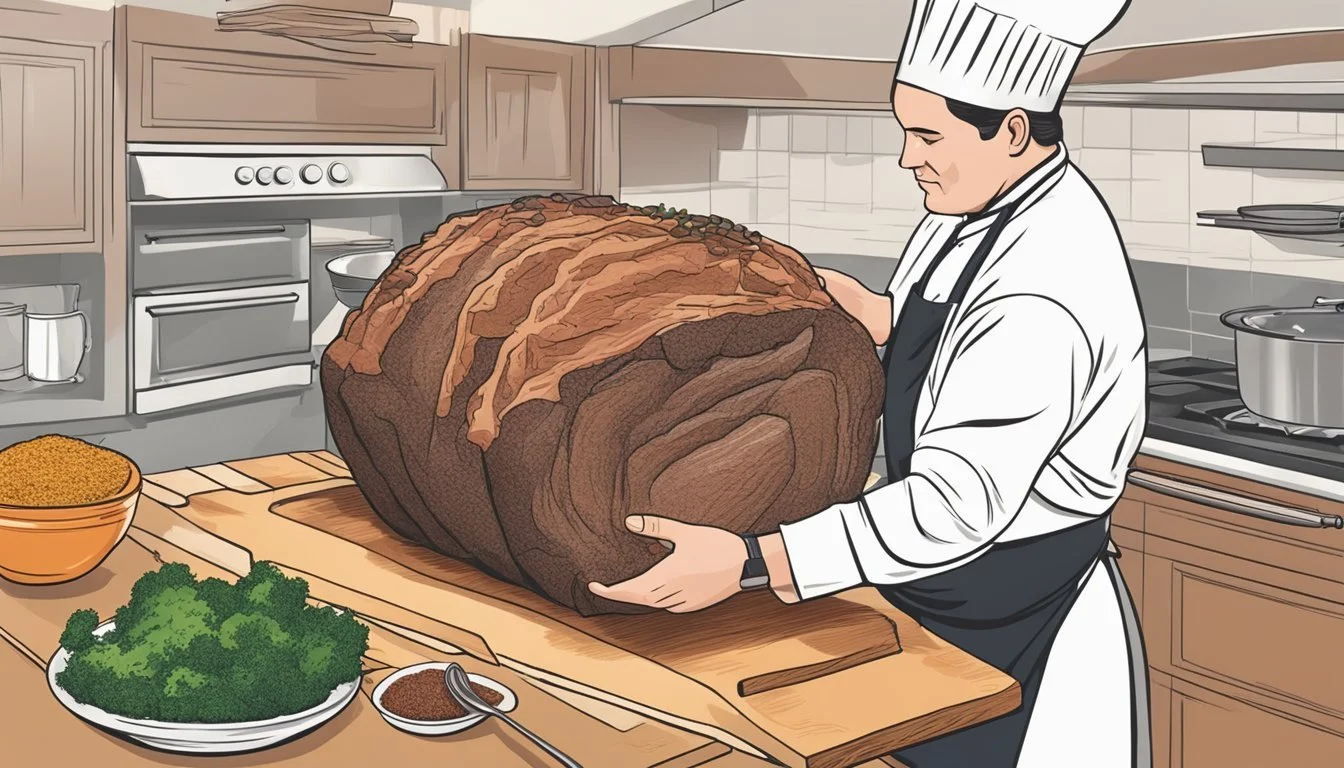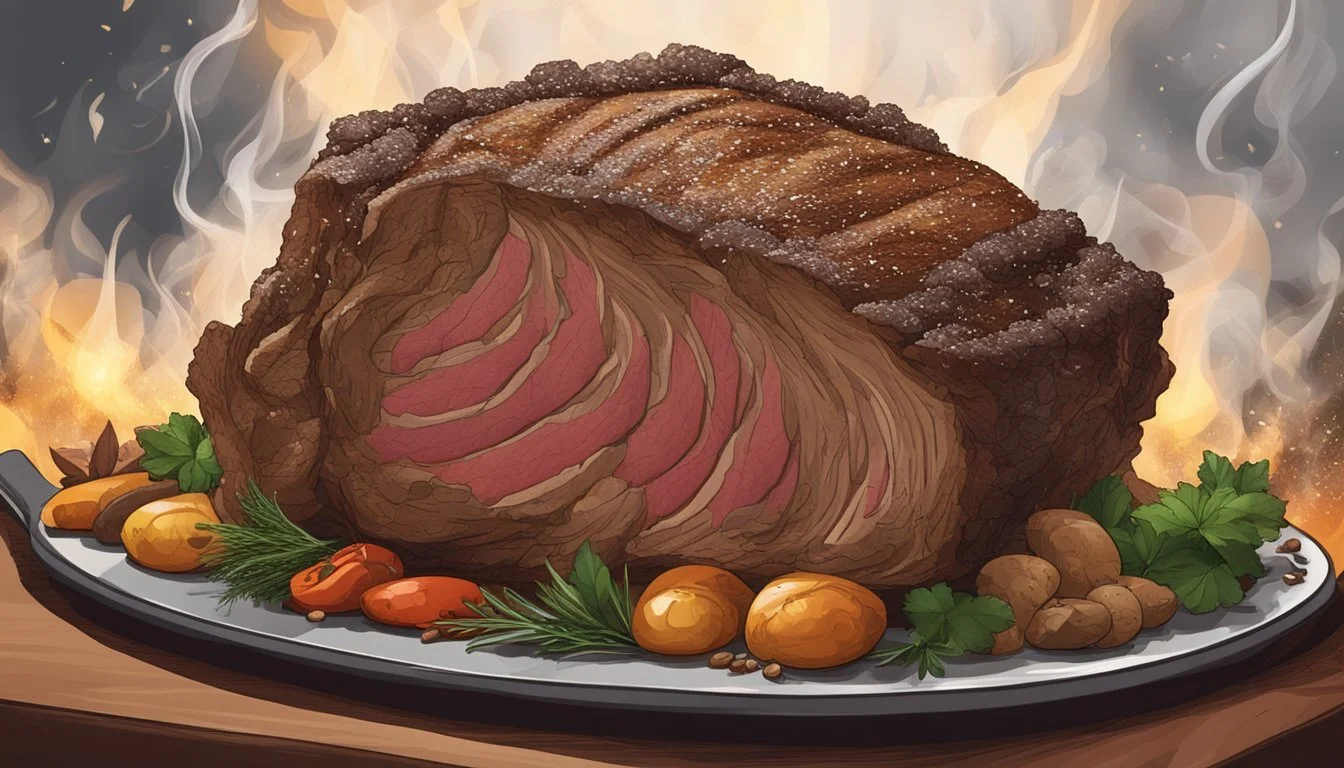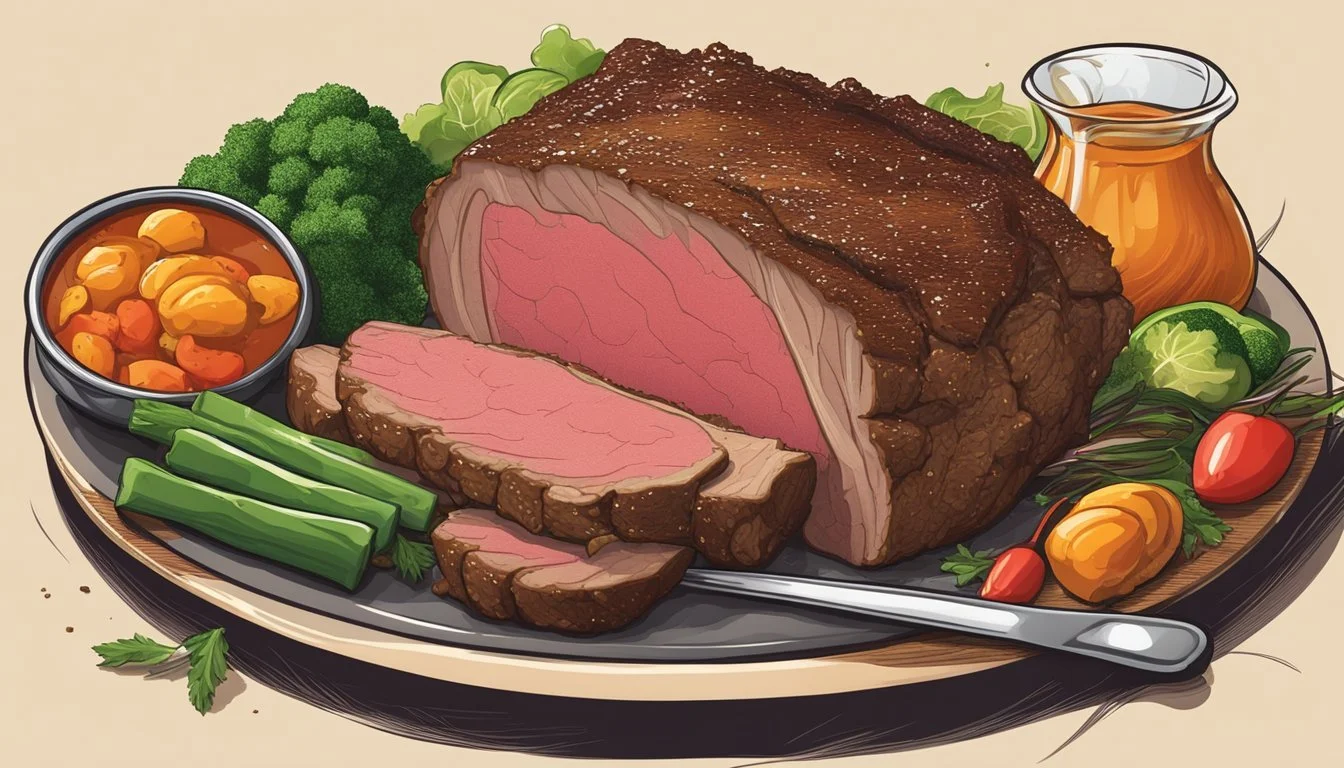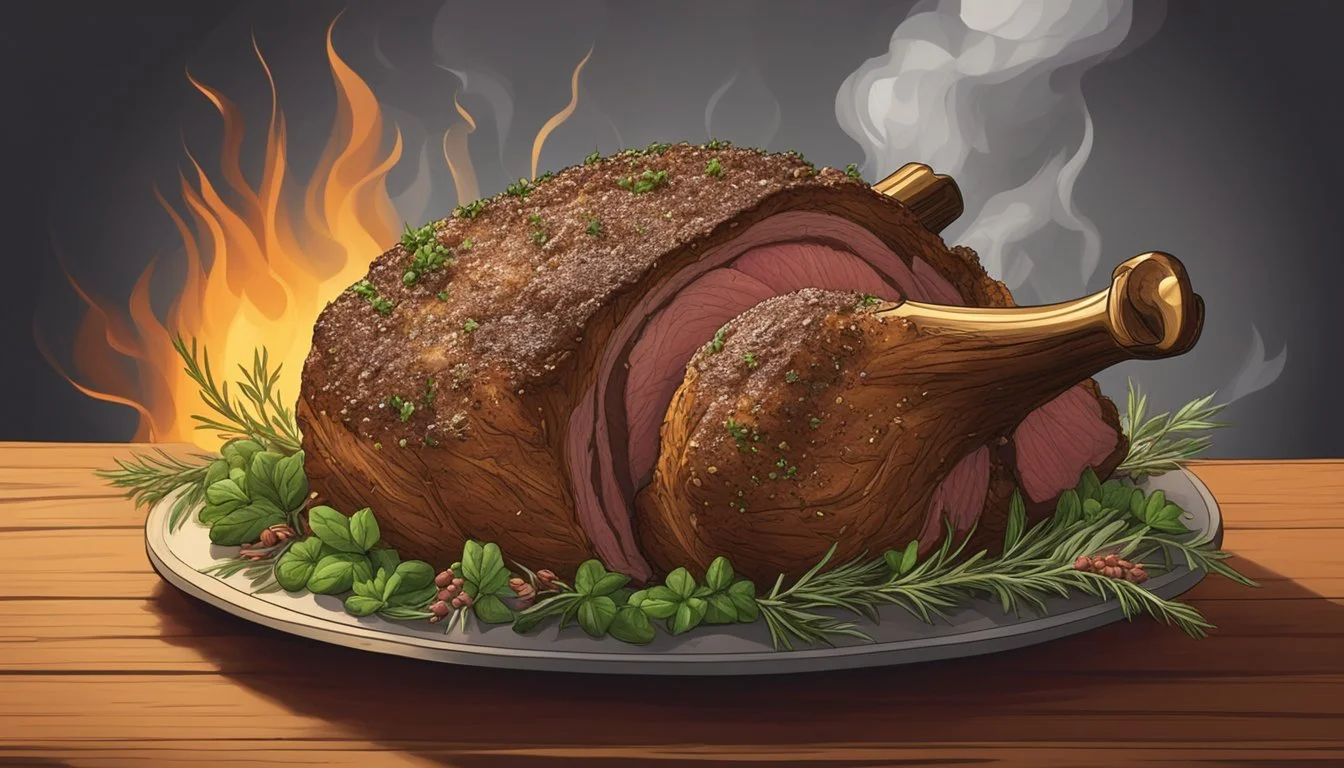How to Cook a Texas-Style Prime Rib Roast
Your Ultimate Guide
Cooking a Texas-style prime rib roast is a culinary endeavor that embraces the bold and robust flavors synonymous with the Lone Star State. This dish is celebrated for its succulent texture and rich taste, making it a centerpiece at many festive gatherings and holiday meals (What wine goes well with holiday meals?). The prime rib, also known as a standing rib roast, is cut from the primal rib section of the cow and is prized for its perfect marbling of fat, which contributes to its flavor and tenderness.
The preparation begins long before the roast hits the oven. A well-cooked Texas-style prime rib relies heavily on the marination and seasoning process. A generous application of spices such as salt, pepper, fresh herbs (how long do fresh herbs last?), and sometimes a hint of garlic and olive oil, allows for the meat to absorb the flavors that will define its crust. Achieving the coveted balance of a crispy exterior and a juicy, medium-rare interior requires precise cooking techniques, attentiveness, and a reliable meat thermometer.
Before cooking, it often involves bringing the meat to room temperature, which can take several hours depending on the size of the roast. The actual cooking method often includes a high-temperature sear to form a flavorful crust, followed by a period of slow roasting at a lower temperature. It's critical to monitor the internal temperature to ensure the prime rib is cooked to perfection. By adhering to these principles, one can master the art of preparing a Texas-style prime rib roast that is both delectable and visually impressive.
Selecting the Prime Rib
Selecting a prime rib roast requires an understanding of beef grades and the characteristics of prime rib. It's essential to make informed decisions to ensure the quality of the roast for a Texas-style preparation.
Understanding Beef Grades
The United States Department of Agriculture (USDA) grades beef based on marbling and maturity. The most common grades are:
USDA Prime: High marbling, tender, and flavorful; ideal for dry-heat cooking like roasting.
USDA Choice: Less marbling than Prime but widely available and very good quality.
USDA Select: Leaner, less marbling, can be less tender and juicy than the higher grades.
Prime Rib Characteristics
When looking for prime rib, one should look for bone-in rib roast which includes at least three ribs. The bone adds flavor and aids in cooking the meat evenly. A key feature to look for is marbling, which refers to the white specks and streaks of fat within the meat. High marbling is prized for contributing to the tenderness, juiciness, and flavor of the roast.
Special Orders from Butchers
For a truly Texas-style prime rib, one might consider placing a special order with a butcher to get:
A roast cut from the chuck end, known for having more fat around and between the muscles, leading to a more flavorful result.
A cut to specific size requirements or to obtain a larger section of ribs.
A specific beef grade, with USDA Prime grade being the most desired for its superior marbling and consequent flavor profile.
By giving attention to these details, one can select a prime rib roast that is well-suited for Texas-style cooking and set the stage for a delicious, memorable meal.
Preparation Steps
Cooking a Texas-style prime rib roast to perfection involves a series of important preparation steps, focused on enhancing flavor and ensuring the meat cooks evenly. The meat should be properly thawed, a rich marinade created, and the roast seasoned well before cooking.
Thawing and Brining
To begin, thaw the prime rib roast completely if it has been frozen. It is essential to place the roast in the refrigerator and allow it to thaw slowly, which could take up to 24 hours depending on the size. After thawing, a proper brine can be applied to ensure the meat retains moisture during cooking. The brine solution should consist of water, kosher salt, and a bit of sugar to balance the flavors.
Creating the Marinade
The next step is to create a rich Texas-style marinade. The marinade should include:
Olive oil: to help the seasoning adhere to the meat and promote an even roast
Soy sauce: for a deep umami flavor
Coarse kosher salt: for seasoning and crust formation
Garlic: minced, as a robust aromatic
Liquid smoke: for that signature Texas smoky taste
Freshly ground black pepper: for heat and complexity
Combine these ingredients in a bowl, ensuring that the garlic and seasonings are well-distributed in the olive oil and soy sauce base.
Seasoning the Meat
Before seasoning, let the prime rib come to room temperature. This allows for even cooking. The roast should rest outside of the refrigerator for approximately an hour. Place the roast on a rack inside a roasting pan.
One can now generously apply the prepared marinade mixture over the entire surface of the meat. It’s important to coat all sides to infuse the roast with the flavors of the marinade. Massage the marinade gently into the meat to better integrate the seasoning. After the meat is thoroughly coated, it should be left to sit and absorb the flavors, preferably for a few hours or, if time permits, overnight in the refrigerator.
Cooking the Prime Rib
Cooking a Texas-style prime rib roast to perfection involves careful attention to oven temperature, internal meat temperature, and appropriate resting time. These factors contribute to producing a tender, juicy, and flavorful main course.
Oven Roasting Basics
To begin, preheat the oven to a high temperature — typically 450 degrees Fahrenheit to create a desirable crust. The prime rib should be allowed to reach room temperature before roasting, ensuring even cooking. Place the rib roast, ideally a well-marbled cut, bone-in or boneless, in a heavy-duty roasting pan. If it is a boneless roast, it is recommended to set it on a rack within the pan to promote consistent air flow and cooking from all sides.
For a smoke-flavored crust, some individuals might include wood chips within the oven or utilize a specific oven setting if available. The rib roast is initially exposed to the high heat to sear the surface, then the oven temperature is lowered — usually to around 325 degrees Fahrenheit — to continue cooking.
Monitoring Internal Temperature
A meat thermometer is vital to monitor the internal temperature and achieve the desired level of doneness: 120 degrees Fahrenheit for rare, 130 degrees Fahrenheit for medium-rare, 140 degrees Fahrenheit for medium, and 150 degrees Fahrenheit for medium well.
Here's a simple table illustrating target internal temperatures for different levels of doneness:
Doneness Temperature (F) Rare 120 Medium-Rare 130 Medium 140 Medium Well 150
Do not rely strictly on cooking time as variations in oven calibration a, size and shape of the cut of meat, and starting temperature of the meat may alter the cook time needed. Instead, monitor the internal temperature regularly with a thermometer.
Resting the Meat Before Serving
After reaching the preferred internal temperature, let the meat rest before slicing. The residual heat will continue to cook the roast slightly, and the juices will redistribute throughout the meat, enhancing tenderness and flavor. For a bone-in roast, tent it loosely with foil to retain heat.
The resting period typically ranges from 15 to 20 minutes for smaller cuts and can extend up to 30 minutes for larger roasts. Carefully collecting the au jus from the roasting pan during this time can provide an excellent sauce to accompany individual slices. Remember, the resting stage is crucial for the meat to achieve its final serving temperature and doneness. After resting, carve the prime rib into thick slices for each guest.
Leftovers can be stored and used for a variety of secondary dishes, making the cost and effort of preparing a prime rib roast an excellent investment in multiple meals.
Finishing Techniques
Once the Texas-style prime rib roast has been cooked to the desired internal temperature, implementing finishing techniques can elevate the flavor profile and presentation. These methods focus on searing the meat for a flavorful crust and creating a complementary sauce using the roast's juices.
Searing for Enhanced Flavor
To sear the prime rib after roasting, one should:
Preheat: Heat a skillet or the roasting pan to a high temperature on the stove.
Sear: Place the roast in the hot skillet and sear each side for about 2-3 minutes or until a brown crust forms, which locks in the juices and enhances the meat's flavor.
Rest: Allow the prime rib to rest after searing. This step ensures that all the juices redistribute and settle within the roast, keeping it succulent.
Making the Perfect Sauce
A rich sauce can be made using the collected juices from the roast:
Deglaze:
After removing the prime rib, add a splash of wine or broth to the roasting pan.
Scrape up the flavorful bits stuck to the pan, which are key for a tasty sauce.
Reduce:
Bring the mixture to a simmer.
Allow it to reduce in volume, which concentrates the flavors.
Season and Serve:
One might add herbs like thyme or rosemary.
Taste and adjust seasoning with salt and pepper. Strain if a smoother sauce is preferred.
The perfect sauce should complement the robust flavors of the prime rib without overwhelming them.
Through searing for additional depth of flavor and making a harmonious sauce, the cooking process is finalized, ensuring that each bite of the Texas-style prime rib roast is a memorable experience.
Serving and Presentation
When serving a Texas-style prime rib roast, presentation is key, and proper technique ensures every slice is as succulent as the next. Guests should anticipate a dinner that’s both visually appealing and deliciously satisfying, with perfectly carved portions and a selection of side dishes to complement the main attraction.
Carving the Prime Rib
One should begin by allowing the bone-in rib roast to rest on a cutting board for approximately 20 minutes after removing it from the oven. This allows the juices to redistribute, ensuring that the meat remains moist and flavorful upon carving. Using a sharp carving knife, they should make an initial cut along the rib bones to remove them—this will simplify carving the rest of the roast. Subsequent slices should be cut across the grain to desired thickness, typically about 1/2 inch. They should aim for even slices to present a visually appealing plate.
Accompaniments and Side Dishes
Bold flavors like cracked black pepper and herb infusions in the rub or crust of the prime rib pair well with a variety of side dishes. A balanced dinner might include:
Starches: A classic option such as garlic mashed potatoes or a baked potato with butter and sour cream.
Vegetables: Roasted asparagus, glazed carrots, or a green bean almondine provide a fresh counterpoint to the rich meat.
Salads: A crisp salad with a tangy vinaigrette dressing helps to cut through the heaviness of the dish.
Au jus or Gravy: A side of au jus or a robust gravy made from the roast’s drippings adds moisture and depth to each serving.
It is noteworthy for the host to have a progression of plates ready for guests, allowing for a seamless transition from carving to serving. Each plate could be prefaced with a portion of side dishes before the prime rib is added to avoid the meat cooling while sides are arranged. To personalize the experience, friends or family might be encouraged to pass around condiments or additional sides, enhancing the communal aspect of the meal.
Additional Cooking Methods
When stepping beyond the traditional oven-roasting method, one might consider smoking or grilling to infuse the prime rib with distinctive flavors and textures synonymous with Texas BBQ.
Smoking for Texas BBQ
Smoking a prime rib imparts a deep, smoky flavor characteristic of Texas BBQ. To achieve this, one should use a smoker and select a quality wood such as hickory or mesquite, which are staples in Texas smoking. Prime grade beef is recommended for its marbling and quality, ensuring a juicy and flavorful outcome. When smoking smoked prime rib, maintaining a consistent fire in the smoker is crucial, typically at a low temperature around 225–250 degrees F for several hours. The meat should reach an internal temperature of 120–130 degrees F for medium-rare before it is taken off to let rest.
Outdoor Grilling Alternatives
For those who prefer the grill, grilling a prime rib can also yield delectable results. A gas grill with multiple burners allows better control of the cooking temperature. One can use indirect heat on a gas grill to mimic roasting conditions. For a charcoal grill or a Weber, position the coals on one side and place the roast on the other to avoid direct heat. To emulate a Texas Roadhouse prime rib recipe or a copycat recipe, consider a generous seasoning rub and a high-heat sear before reducing the heat. A steak-like crust forms during an initial sear over direct heat, followed by a move to indirect heat to finish cooking. After grilling, it is imperative to let the prime rib rest before slicing to retain its juices and reach optimal tenderness.
Storing and Reusing Leftovers
When managing leftovers from a Texas-style prime rib roast, one must ensure proper storage to maintain quality and safety. Additionally, repurposing the prime rib into exciting dishes maximizes both flavor and value from the original meal.
Proper Storage Techniques
To properly store leftover prime rib, one should cool the meat to room temperature promptly after serving to prevent bacterial growth. Once cooled:
Wrap the meat tightly in aluminum foil or place it in an airtight container.
Refrigerate the wrapped leftovers within two hours of cooking. The refrigerator should be set at below 40°F (4°C).
Keeping the meat intact will slow down its drying out process. If it is already sliced, extra care is needed to retain moisture.
Leftover prime rib can be stored in the refrigerator for approximately 3-4 days. For longer storage, it can be frozen for up to three months.
Creative Uses for Leftover Prime Rib
Leftover prime rib offers a versatile base for a variety of dishes. Here are a few creative uses:
Turning Leftovers into Steak or Bacon-Inspired Dishes:
Steak Tacos: Thinly slice the prime rib and warm it up in a pan. Serve with tortillas, salsa, and avocado.
Prime Rib and Eggs: Chop the prime rib into cubes and fry with potatoes and onions for a breakfast hash. Top with a fried egg.
Bacon-Like Snack: Cut the prime rib into strips, season with a smoky rub, and lightly pan-fry until crisp.
Reviving Meat without Drying It Out:
Steaming Method: Place sliced prime rib in a foil pouch and steam for 3-6 minutes.
Oven Method: Reheat in the oven at 250°F (120°C), covered loosely with foil, for 15-20 minutes.
Utilizing these methods can breathe new life into the prime rib, ensuring that the leftovers are just as enjoyed as the original roast.
Expert Tips and Tricks
When cooking a Texas-style prime rib roast, the devil is in the details. The right tools, precise temperatures for doneness, and high-quality ingredients are pivotal to achieving the perfect flavor and texture.
Selecting the Right Cooking Accessories
A sturdy rack set into a large pan is essential for even cooking of a prime rib roast. The rack allows heat to circulate around the meat, while the pan captures drippings that are crucial for making a flavorful sauce. For optimal results, one should consider a heavy-duty thermometer; a digital thermometer can ensure the roast reaches the perfect level of doneness without the need for constant checking.
Rack: Elevates the roast for even cooking
Pan: Collects drippings, aids in sauce creation
Achieving Your Desired Level of Doneness
The internal temperature is the true indicator of your prime rib's level of doneness. A prime rib should usually be removed from the oven when it's 5-10 degrees Fahrenheit below the desired final temperature, as it will continue to cook while resting. Here is a guide for internal temperatures:
Doneness Temperature Rare 115-120°F Medium Rare 125-130°F Medium 135-140°F Medium Well 145-150°F Well Done 155°F+
Using a reliable meat thermometer is the best way to prevent undercooking or overcooking your roast.
The Importance of Quality Ingredients
High-quality ingredients are the backbone of a truly tender and flavorsome Texas-style prime rib. One should select a well-marbled cut for tenderness and invest in fresh, top-quality seasoning and marinade ingredients to enhance the flavor. Allowing the meat to rest adequately after cooking is also critical, as it lets the juices redistribute throughout the roast, ensuring a moist and tender final product.
Tender: Achieved by selecting quality meat with good marbling
Flavor: Enhanced with fresh herbs and spices
The experience of enjoying a perfectly cooked Texas-style prime rib relies on careful attention to each of these components. They set the foundation for a successful culinary endeavor.
Frequently Asked Questions
What temperature should a Texas-style prime rib roast be cooked at?
Texas-style prime rib roast should initially be cooked in a preheated oven at a high temperature such as 450 degrees Fahrenheit for about 15 minutes. Then, the temperature should be lowered to 325 degrees Fahrenheit for the remaining cooking time to achieve even doneness.
How do you determine the internal temperature for prime rib?
For medium-rare, a prime rib roast should reach an internal temperature of 120-130 degrees Fahrenheit. Use a meat thermometer for accuracy. Keep in mind that the meat's temperature will rise about 5-10 degrees after being removed from the oven during the resting phase.
How long should prime rib roast be cooked?
Rare (120-125 degrees F): About 15 minutes at 450 degrees F, then an additional 1.5 to 2 hours at 325 degrees F.
Medium Rare (130-135 degrees F): 15 minutes at 450 degrees F, followed by 2 to 2.5 hours at 325 degrees F.
Medium (135-145 degrees F): Begin with 15 minutes at 450 degrees F, then cook for 2.5 to 3 hours at 325 degrees F.
How many servings can you get from a prime rib roast?
A full prime rib roast, which usually consists of 7 ribs, can serve about 14 people (half a pound per person). A smaller roast with fewer ribs can be proportioned accordingly.
Are there specific recipes for a Texas-style prime rib roast?
Texas-style recipes often include bold spices and a dry marinade preparation. The most important step is to season the meat generously and allow it to marinate, covered, in the refrigerator for at least 24 hours to develop the flavors effectively.
Nutritional Information
When preparing Texas-style prime rib roast, it is important to be mindful of its nutritional content. The prime rib, being a rich cut of beef, is known for its high caloric value and significant fat content. The following is a concise breakdown:
Per Serving (Based on 3 oz of cooked meat):
Calories: Approximately 250-300
Total Fat: 20-24 grams
Saturated Fat: 9 grams
Trans Fat: 0 grams
Cholesterol: 70-75 milligrams
Protein: 17-20 grams
Sodium: 55-60 milligrams
Carbohydrates: 0 grams
Sugars: 0 grams
Fiber: 0 grams
Servings size can vary, but for a standard roast, one might consider a single serving to be about 3 ounces of cooked meat. This portion size helps in managing caloric intake.
The prime rib roast is nutritionally dense and provides essential nutrients, such as iron and B vitamins, particularly vitamin B12, which is crucial for nerve health and the production of DNA.
In the context of a balanced diet, consider the following:
Leaner Portions: Opt for slices with less visible fat to reduce total fat intake.
Portion Control: Stick to the recommended serving size to maintain a balanced calorie intake.
Balanced Sides: To complement the richness of the prime rib, include non-starchy vegetables and whole grains on the side.
Please note, the exact nutritional values can vary based on factors such as the specific cut of the roast, additional ingredients used in preparation, and cooking method. Always use a food scale for a precise serving size and consider consulting a nutritional database or a professional when exact nutritional information is necessary for dietary planning.
Conclusion
Cooking a Texas-style prime rib roast is a gratifying experience for any chef, accomplished or novice. To achieve that succulent, tender result, one must approach the process with patience and precision. A consistent oven temperature, accurate meat thermometer readings, and proper resting time are the cornerstones of a perfectly cooked prime rib roast.
A few final tips to ensure Prime Rib success:
Temperature Management: Cooking at a low temperature of around 200°F before finishing with a high-heat blast ensures even cooking and a savory crust.
Seasoning: The rub used can be tailored to personal preference, but traditional Texas flavors such as garlic, thyme, and rosemary are recommended for authenticity.
Resting Time: Rest the meat for at least 15 minutes before carving. This allows the juices to redistribute, making sure every slice is as moist as the last.
Endeavor to use these guiding principles and your Texas-style prime rib will be a testament to your culinary skills. Whether it's a festive occasion or a sumptuous weekend meal, the eye-catching centerpiece is bound to be both delicious and memorable.











